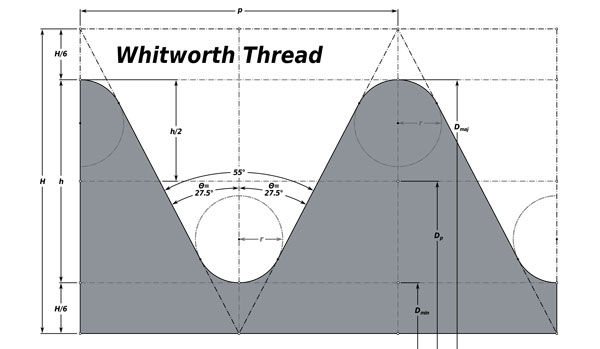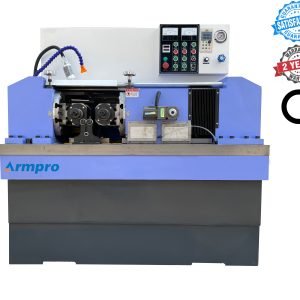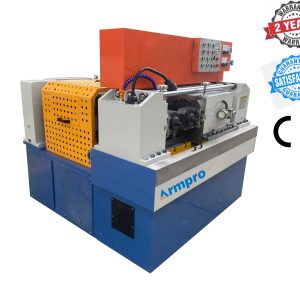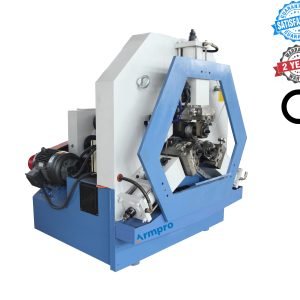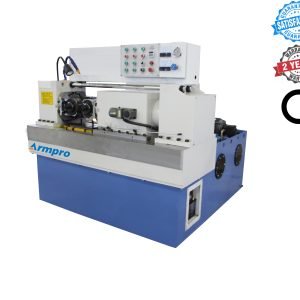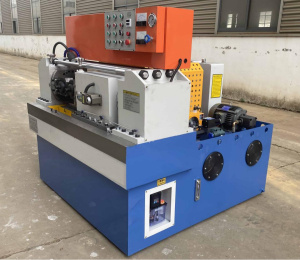British Standard Whitworth (BSW) Coarse Pitch Size Chart
-
British Standard Whitworth (BSW)
The British Standard Whitworth (BSW) thread is known as a screw thread profile used for fastening applications in the United Kingdom and many other countries.
- It was developed by Sir Joseph Whitworth in the middle of the 19th century and was one of the first standardized thread forms.
- While the BSW thread has largely been replaced by the metric system, it remains in use in some specialized applications and in older equipment.
1. What is the British Standard Whitworth (BSW) thread parameter?
The BSW thread parameters include:
- Thread Angle:There should be a 55-degree thread angle, which means the thread profile forms a 55-degree angle with the screw axis.
- Pitch:In the BSW system, the pitch is specified in threads per inch (TPI).
- Major Diameter:The largest diameter of the thread is called the major diameter, also known as the outside diameter. It is determined by measuring across the crests of an external thread and between the roots of an internal thread.
- Minor Diameter:The minor diameter is the smallest diameter of the thread and it is often called the root diameter. For an external thread, it is measured between the roots. For an internal thread, it is measured across the troughs.
- Crest and Root Radius:These are the radii of curvature at the crests and roots of the thread profile. In the BSW system, the thread profile is rounded, and the radii are part of the specification.
2. What is the British Standard Whitworth (BSW) thread size chart?
The British Standard Whitworth (BSW) thread size chart provides information on the various thread sizes available under this system.
BSW threads are defined by their diameter and thread count per inch (TPI). Below is a sample BSW thread size chart that includes some common sizes.
| THREAD DATA CHART: | ||||||||
| British Thread (British Standard Whitworth) -- Coarse Pitch | ||||||||
| Nominal Size Ww |
Thread Form Type |
Major Diameter mm d=D |
Pitch mm p |
Threads per inch tpi |
Pitch Diameter mm d2=D2 |
Minor Diameter Male Thd. d3 |
Thread Height H1 |
Tap Drill Diameter mm |
| 1/16" | BSW | 1.587 | 0.423 | 60 | 1.315 | 1.050 | 0.270 | 1.15 |
| 3/32" | BSW | 2.381 | 0.529 | 48 | 2.041 | 1.703 | 0.338 | 1.90 |
| 1/8" | BSW | 3.175 | 0.635 | 40 | 2.768 | 2.362 | 0.406 | 2.50 |
| 5/32" | BSW | 3.969 | 0.793 | 32 | 3.459 | 2.952 | 0.507 | 3.20 |
| 3/16" | BSW | 4.762 | 1.058 | 24 | 4.084 | 3.407 | 0.677 | 3.70 |
| 7/32" | BSW | 5.556 | 1.058 | 24 | 4.878 | 4.201 | 0.677 | 4.50 |
| 1/4" | BSW | 6.350 | 1.270 | 20 | 5.537 | 4.724 | 0.813 | 5.10 |
| 5/16" | BSW | 7.938 | 1.411 | 18 | 7.034 | 6.131 | 0.904 | 6.50 |
| 3/8" | BSW | 9.525 | 1.588 | 16 | 8.509 | 7.492 | 1.017 | 7.90 |
| 7/16" | BSW | 11.113 | 1.814 | 14 | 9.951 | 8.789 | 1.162 | 9.20 |
| 1/2" | BSW | 12.700 | 2.117 | 12 | 11.345 | 9.990 | 1.355 | 10.40 |
| 5/8" | BSW | 15.876 | 2.309 | 11 | 14.397 | 12.918 | 1.479 | 13.40 |
| 3/4" | BSW | 19.051 | 2.540 | 10 | 17.424 | 15.798 | 1.627 | 16.25 |
| 7/8" | BSW | 22.226 | 2.822 | 9 | 20.419 | 18.611 | 1.807 | 19.25 |
| 1" | BSW | 25.400 | 3.175 | 8 | 23.368 | 21.335 | 2.033 | 22.00 |
| 1-1/8" | BSW | 28.576 | 3.629 | 7 | 26.253 | 23.929 | 2.324 | 24.50 |
| 1-1/4" | BSW | 31.751 | 3.629 | 7 | 29.428 | 27.104 | 2.324 | 27.25 |
| 1-3/8" | BSW | 34.926 | 4.233 | 6 | 32.215 | 29.505 | 2.711 | 30.25 |
| 1-1/2" | BSW | 38.100 | 4.233 | 6 | 35.391 | 32.680 | 2.711 | 33.50 |
| 1-5/8" | BSW | 41.277 | 5.080 | 5 | 38.024 | 34.771 | 3.253 | 35.50 |
| 1-3/4" | BSW | 44.452 | 5.080 | 5 | 41.199 | 37.946 | 3.253 | 38.50 |
| 1-7/8" | BSW | 47.627 | 5.645 | 4 1/2 | 44.012 | 40.398 | 3.614 | 41.25 |
| 2" | BSW | 50.802 | 5.645 | 4 1/2 | 47.187 | 43.573 | 3.614 | 44.50 |
| 2-1/4" | BSW | 57.152 | 6.350 | 4 | 53.086 | 49.020 | 4.066 | 50.00 |
| 2-1/2" | BSW | 63.502 | 6.350 | 4 | 59.436 | 55.370 | 4.066 | 56.00 |
| 2-3/4" | BSW | 69.853 | 7.257 | 3 1/2 | 65.205 | 60.558 | 4.647 | 61.50 |
| 3" | BSW | 76.203 | 7.257 | 3 1/2 | 71.556 | 66.909 | 4.647 | 68.00 |
| 3-1/4" | BSW | 82.553 | 7.816 | 3 1/4 | 77.548 | 72.544 | 5.005 | 73.75 |
| 3-1/2" | BSW | 88.903 | 7.816 | 3 1/4 | 83.899 | 78.894 | 5.005 | 80.00 |
| 3-3/4" | BSW | 95.254 | 8.467 | 3 | 89.832 | 84.410 | 5.422 | 85.50 |
| 4" | BSW | 101.604 | 8.467 | 3 | 96.182 | 90.760 | 5.422 | 92.00 |
| 4-1/4" | BSW | 107.954 | 8.835 | 2 7/8 | 102.297 | 96.639 | 5.657 | 98.00 |
| 4-1/2" | BSW | 114.304 | 8.835 | 2 7/8 | 108.647 | 102.990 | 5.657 | 104.20 |
| 4-3/4" | BSW | 120.665 | 9.237 | 2 3/4 | 114.740 | 108.625 | 5.915 | 110.00 |
| 5" | BSW | 127.005 | 9.237 | 2 3/4 | 121.090 | 115.176 | 5.915 | 116.50 |
| 5-1/4" | BSW | 133.355 | 9.677 | 2 5/8 | 127.159 | 120.963 | 6.196 | 122.50 |
| 5-1/2" | BSW | 139.705 | 9.677 | 2 5/8 | 133.509 | 127.313 | 6.196 | 128.50 |
| 5-3/4" | BSW | 146.055 | 10.160 | 2 1/2 | 139.549 | 133.043 | 6.506 | 134.50 |
| 6" | BSW | 152.406 | 10.160 | 2 1/2 | 145.900 | 139.394 | 6.506 | 141.00 |
BSW Thread Size Chart (External Threads)
| Diameter (inches) | Threads per Inch (TPI) | Pitch (inches) |
| 1/8" | 40 | 0.025 |
| 5/32" | 32 | 0.03125 |
| 3/16" | 24 | 0.04167 |
| 1/4" | 20 | 0.05 |
| 5/16" | 18 | 0.05556 |
| 3/8" | 16 | 0.0625 |
| 7/16" | 14 | 0.07143 |
| 1/2" | 12 | 0.08333 |
| 5/8" | 11 | 0.09091 |
| 3/4" | 10 | 0.1 |
| 7/8" | 9 | 0.11111 |
| 1" | 8 | 0.125 |
| 1 1/8" | 7 | 0.14286 |
| 1 1/4" | 7 | 0.14286 |
| 1 3/8" | 6 | 0.16667 |
| 1 1/2" | 6 | 0.16667 |
| 1 3/4" | 5 | 0.2 |
| 2" | 4 1/2 | 0.22222 |
BSW Thread Size Chart (Internal Threads)
| Diameter (inches) | | Threads per Inch (TPI) | | Pitch (inches) |
| 1/4" | 20 | 0.05 |
| 5/16" | 18 | 0.05556 |
| 3/8" | 16 | 0.0625 |
| 7/16" | 14 | 0.07143 |
| 1/2" | 12 | 0.08333 |
| 9/16" | 12 | 0.08333 |
| 5/8" | 11 | 0.09091 |
| 3/4" | 10 | 0.1 |
| 7/8" | 9 | 0.11111 |
| 1" | 8 | 0.125 |
| 1 1/8" | 7 | 0.14286 |
| 1 1/4" | 7 | 0.14286 |
| 1 3/8" | 6 | 0.16667 |
| 1 1/2" | 6 | 0.16667 |
| 1 3/4" | 5 | 0.2 |
| 2" | 4 1/2 | 0.22222 |
Please note that this is not an exhaustive list, and additional sizes are available.
As the BSW thread system is not as commonly used today, It is advised to consult official standards or technical resources for the most up-to-date and accurate information on BSW threads if you are working on a specific project or need precise information.
3. What are the applications of the British Standard Whitworth (BSW) thread?
The BSW coarse pitch size chart follows a system where the thread pitch is relatively large, resulting in threads that are more robust and suitable for heavy-duty applications. But the metric thread system is widely used on a global scale today due to its ease of use, standardization, and compatibility with modern manufacturing practices. Despite the decline in popularity, the BSW standard still finds usage in certain applications, especially in older machinery, vehicles, and equipment. It holds historical significance and remains a subject of interest for collectors, restoration enthusiasts, and those dealing with vintage machinery. Here are some of the typical applications of the BSW thread:
- Historic machinery:There was widespread use of BSW threads in older machinery and equipment, particularly in the United Kingdom and other countries that adopted this standard during its peak.
- Restorations and repairs:BSW threaded fasteners are frequently required for the restoration and maintenance of antique machinery, vehicles, and equipment. In order to maintain historical accuracy and functionality, this standard must be maintained.
- Woodworking:BSW threads have found applications in woodworking, especially in traditional joinery and antique furniture restoration.
- Plumbing:There were some areas where BSW threads were used in plumbing applications, including connecting pipes and fittings.
- Automotive:Although the automotive industry has largely switched to metric threads, some vintage cars and motorcycles may still use BSW threads for certain components.
- Aviation:There may be parts on some older aircraft with these threads, especially those manufactured in the UK or other countries with a historical preference for BSW threads.
- However, if someone encounters a need for BSW threaded fasteners or components, it's essential to ensure to source the appropriate parts from specialized suppliers or antique restoration specialists as BSW threads still remain in specific niche applications and historical contexts.
4. How to make British Standard Whitworth (BSW) thread?
Creating a British Standard Whitworth (BSW) thread involves a specific set of steps and measurements which must be followed in order to ensure accuracy and compatibility with existing standards. Here is a general guide on how to make a BSW thread:
Tools and Materials Needed:
- Lathe or thread-cutting machine
- BSW tap and die set
- Workpiece (material to be threaded)
- Cutting fluid or lubricant
- Micrometer or calipers
- Center punch
- Lathe cutting tool
Steps to Make a BSW Thread:
- Select the Workpiece
First the material for the workpiece should be chosen. Metals like steel, brass, or aluminum are frequently used alternatives for the material. The diameter of the selected workpiece should match the desired BSW thread size.
- Measure the Diameter
Next, the diameter of the workpiece should be measured. A micrometer or calipers are used to measure it accurately. For BSW threads, the diameter is measured in inches.
- Calculate the Pitch
The pitch for BSW threads is specified in threads per inch (TPI). Here, it must be ensured to select the appropriate pitch for the desired BSW thread. The standard pitches for various BSW thread sizes can be found in reference tables.
- Mark the Workpiece
The starting point of the thread on the workpiece should be marked by using a center punch. This will help to align the tap or die properly.
- Prepare the Lathe
The lathe or thread-cutting machine will be setting up with the proper speed and feed settings for the material working with.
- Mount the Workpiece
It must be ensured that the workpiece in the lathe chuck or collet is properly centered and secured here.
- Cutting the Thread
need to use the appropriate BSW tap or die from the existing tap and die set.
- Align the Tap or Die
Then the tap or die will be aligned carefully with the center punch mark on the workpiece and start turning the tap or rotating the die by hand to create initial threads. To avoid creating a misaligned or damaged thread, must be sure to keep the tap or die perpendicular to the workpiece.
- Thread Cutting
Once the initial threads are established, the thread will be cutting continuously using the lathe or thread-cutting machine. in this process, the appropriate cutting depth and speed for the material and thread size should be followed. Also, smooth and consistent movements should always be used.
- Check the Thread Quality
The thread's quality should be periodically checked using a thread gauge or thread pitch gauge to ensure it matches the BSW standard.
- Finishing
Once the thread is fully cut, the workpiece should be removed from the lathe or thread-cutting machine. Any rough edges or burrs can be cleaned if necessary.
Creating precise BSW threads requires skill and practice. If someone is new to thread-cutting, it's a good idea to practice on scrap material before working on the final project. Additionally, having access to BSW reference tables and technical guides can be beneficial for selecting the correct thread size and pitch.
5. Conclusion
The British Standard Whitworth (BSW) coarse pitch size chart has historically been a significant standard for screw threads mainly in the United Kingdom. Over time, as technology and manufacturing practices evolved, the BSW standard faced competition from other thread standards, such as the Metric system. But it still has niche applications in certain industries as it offers several advantages in them.
BSW threads are maintaining compatibility with older machinery and has a well-established standard. Because they have relatively larger pitches, BSW threads are more robust and suitable for heavy-duty applications. Moreover, they provide better resistance to galling as well as to loosening due to vibrations. The BSW standard is still used for many decades due to its high reliability.
Don't forget to share this post!
Related Products
CONTACT US
Tell us your raw material and working details to get quotations within 24 hours.
WhatsApp Us: +86 159 27 555863
Want the best price & newest metal working machinery buying guide,tips and trends sent straightly to your box?Sign up for Armpro's monthly newsletter,we're free for your consultation and Offer you the most suitable working solutions!
The Buyer's Guide
- Tapping Machine: The Ultimate Buying Guide in 2021
- Electric Tapping Machines:the Ultimate Buying Guide in 2021
- Drilling Machine: The Ultimate Buying Guide in 2021
- Grinding Machine:The Ultimate Buying Guide in 2021
- Metal Band Saw Machine :The Complete Buying Guide in 2021
- Pneumatic Tapping Machine:The Complete Importing Guide in 2021
- Bench Tapping Machine:The Complete Buying Guide in 2021
- CNC Tapping Machine:The Complete Buying Guide In 2021
- Magnetic Base Drill Machine:The Ultimate Buying Guide in 2021
- Drilling And Tapping Machine:The Complete Buying Guide in 2021
Most Popular
Tell us your material or budget,we'll reply you ASAP within 24 hours
